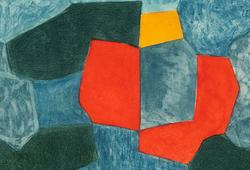Nick Brandt
"Railway Line With Lion Brothers", 2015
From the series "Inherit the Dust". Signed Nick Brandt and dated 2016, numbered 6/15, on the label verso. Pigment print, image 96 x 250 cm. Including frame 130 x 285 cm.
Provenance
The Perfect World Foundation.
Private Collection, Sweden.
Literature
Nick Brandt, "Inherit the Dust, 2016, illustrated.
More information
“I conceived this project [Inherit the Dust] in early 2014 - to photograph life-size panels of animals in locations where they used to roam but, as a result of human impact on the environment, no longer do. Initially, I wondered whether I would find the locations that matched my pessimistic imaginings of a world in environmental disintegration. I was concerned that I might be exaggerating, overdramatizing.
Over the years, I’ve driven through countless areas where just ten to twenty years ago there was animal life, but now has been relentlessly wiped out - sliced up and reduced to bush meat, leaving vast expanses of land devoid of any large mammals.
In many of those places, however, even the recent absence of animals in a landscape can still appear relatively undramatic. Of course, it’s only when you know what was there before that the loss is more keenly felt: the herds of elephants, giraffes and gazelles that not so long ago quietly moved across the plains and amongst the acacia trees, the heart-stopping sound of lions roaring on the still air at dusk and dawn. All deathly silent now.
There are many other places where the absence of animals is much more comprehensible, especially where cities expand outwards, or completely new towns and factories rise up. It’s in some of these places where I took the photos in this book. But when you look through the photos, they actually cannot begin to capture the sheer scale of man’s astonishingly rapid and escalating expansion into, and destruction of, the natural world.
The point is, by the end of the shoot, I realized that my concern that I could be exaggerating or overdramatizing was completely unfounded. In fact, just the opposite: how on earth to capture the real scale and speed of destruction in a photograph? I still don’t really have the artistic solution to that one.
As my crew and I moved from location to location during the shoot, I continued to be disturbed and depressed: Time and again, places where zebras roamed only two years earlier, now whole new towns had risen out of the ground at extraordinary speed. One of those places is in the photo, Road with Elephant, 2014. That scene may look like a town disintegrating back into the earth, but it is actually moving in the opposite direction, spreading upwards and outwards.
Frequently on the location scout before the shoot, I would select somewhere, only to return just four weeks later to discover it built up and out in such dramatic ways that it was quite fundamentally changed. In fact, the speed of development in this part of Africa reminds me of what I have seen in one other place in the world: China.”
Quote from nickbrandt.com

































